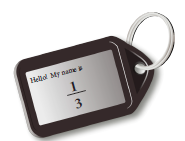Discussion/Introduction
This lesson plan is meant to follow another; 3rd Grade Fractions on the Number line. These lessons are both aligned to Common Core Standard 3.NF.2. Here I’ll assume you’ve gone through that first lesson, and that your students are comfortable marking off intervals to show 1/b on the number line.
In your last lesson your students will have stayed in their chairs during most of the class period, working hard on dividing up fraction intervals and coming to terms with the idea that 1/b on a number line means portioning the interval between 0 and 1 into b parts and then, starting at zero, marking off one of these parts. Today you get to cement that concept a bit more by taking the next step up: your students will discover that a/b means that, starting at 0, you mentally hop a ‘1/b’ size steps toward 1.
That’s all they need to learn today, but you want them to know it backwards, forwards, and inside-out. Since there’s no better way to get to that point than with a fun de-stressing game, you’ll do this by getting your students up out of their chairs for a rousing game of ‘hopscotch fractions’. Games have a way bringing book learning from the ‘theoretical’ category into ‘real life’, and this one is no exception.
Objective
That students would be comfortable representing a fraction a/b on a number line diagram by marking off a lengths 1/b from zero, and that they’d understand that the resulting interval has size a/b, and that its endpoint locates the number a/b on the number line.
Supplies
- Large 0-2 number lines, laminated and taped to the floor (ideal length: 3 or 4 feet long). These can also be prepared by taping standard printing paper end to end and drawing the number lines with markers, using rulers for uniformity. You’ll need one for every four students.
- Strips of colored paper the same size as one unit on the number line; one per student; four colors.
- A marker for each student; four colors; each student’s marker must be coordinated with his paper.
- Fraction Nametags (download printable)
- Hopscotch Flashcards (download printable; print 1 per page)
- Three types of stickers (ideally, small stars in red, yellow, or green; but other simple colored stickers can substitute).
Methodology/Procedure
Begin by reviewing what you taught in the last lesson. Remind the students that we talked about what fractions of abstract numbers mean, and we learned that they work in exactly the same way as fractions of tangible, concrete things like apples. Draw your 0-2 number line on the board, mark 0, 1, and 2, and ask how you would find out where to mark 1/3. After listening to their suggestions, take a strip of paper the size of a unit on your number line, divide it in thirds, and use that to mark 1/3.
Then ask your students how you’d mark 2/3. Give them permission to discuss it with their neighbors, then ask for a volunteer to come and demonstrate it on the board. He will most likely demonstrate it correctly; laying your 1/3 strip end to end twice to find the 2/3 point.
If he doesn’t, or if the idea still seem counterintuitive to many of your students, go back to the idea of distance. Get a volunteer to come stand beside you and then walk three steps away. Ask him to come one third of the distance back (1 step). Then ask him to go back, and tell him now to come two thirds of the distance to you. Continue with other volunteers and other fractions until your students are comfortable with the idea.
Then transfer this idea onto your number line, and show how starting at zero and measuring two 1/3rds brings you to the 2/3 point on your number line.
Then have the children help you move tables and chairs to the back, so that you have a large empty space to work. If a gym or other large empty room is available, you may want to move there for the rest of this class. Otherwise, tailor the size of your number lines to match the available space.
Set up the number lines on the floor. Each number line will have four children manning it, so you’ll need to have as many number lines as the number of children in your class divided by four. These number lines will preferably be arranged side by side, in a line.
Assign the students to teams; four students to each number line. Give each student a strip of colored paper the size of one unit on their floor number lines. Then assign each student a fraction: in every group, you need a 1/3 student, a ¼ student, a 1/6 student, and a 1/8 student. Tape the designations on each student’s shirt. For a ‘handicapped race’ effect, give 1/3 and ¼ designations to the slower students, 1/6 and 1/8 designations to those that are faster. Each student will be called on the same number of times, but students with smaller fractions will have to do more counting and hopping.
Hand out the number strips and markers; in each group, one of each color. It helps organization if you give all students representing a particular fraction the same color.
If you have one odd student out, make him the caller. If you have two or three odd ones out, give them a number line and fractions.
Ask the students to mark where their fractions are on their number lines: 1/3, ¼, 1/6, and 1/8. They will do this with the strips of paper, folding them into appropriate sections as they did in yesterday’s lesson, and using those sections as rulers. Tell them to keep these strips of paper folded after they’ve used them. These strips are their ‘shoes’, and they’ll be needed again and again throughout the game.
Describe the game to them. The caller (you, if there wasn’t an extra student) stands at the front of the room with a pile of full-sized shuffled ‘hopscotch flashcards’. He picks one, displays it, and reads it out. Immediately the students representing that fraction take their ‘shoe’ – the paper strip—mark off the appropriate number of intervals, and then jump, once in each interval, to the fraction marker. For instance, if the caller picked “4/6” the 1/6 player would measure off 4 ‘1/6’ measures with his paper shoe, and then, as soon as they are measured, hop down to the fourth one, doing a one foot jump in each place. The first three to successfully measure and jump are awarded stickers on their fraction nametags: red for the first to hop to place, yellow for the second, and green for the third. Then they go back to the beginning, and the caller calls again.
They will soon discover that after they’ve been called once future calls are easier, as they will have marked off some (maybe all) of their fractions on the number line. Since they are using their colored markers, it will be easy to tell their intervals versus their team-mates. Before the game is halfway done, you should have no measuring at all; just quick, sure hopping when a new fraction is called.
Throughout the game, continue to interweave your class objectives with the game by asking at intervals, randomly, but of every student at least once: How far did you jump? (a steps) What was the size of the interval you jumped through (a/b)? Where is the point a/b on the number line (at the end of a 1/b steps).
Play as long as time permits; the game speeds up as you go, so you should be able to get through the stack of flashcards twice. At the end of the game the stars get tallied up on a per team basis: red is three points, yellow two points, green one point. The team with the greatest number of points wins.
Common Core Standards
This lesson plan is aligned to the Common Core Standard 3.NF.2. That item reads, in part:
3.NF.2. (b). Represent a fraction a/b on a number line diagram by marking off a lengths 1/b from 0. Recognize that the resulting interval has size a/b and that its endpoint locates the number a/b on the number line.
Web Resources/Further Exploration
This lesson plan gives you one fun way of making fractions come alive, but it’s best to approach every topic from multiple angles. That’s why I’m recommending Mathwarehouse’s wonderful fraction resources again— after all, they’re all free!


